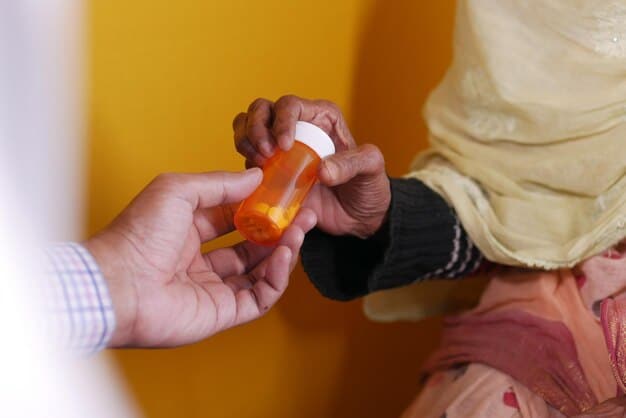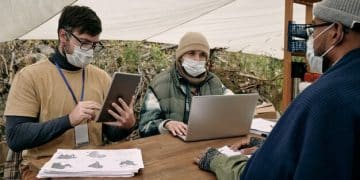The Opioid Crisis: Public Health Strategies and Effectiveness in the US

The Opioid Crisis in the US demands effective public health strategies, including prevention, treatment expansion, and harm reduction, to mitigate its devastating impact on communities.
The opioid crisis continues to be a major public health challenge in the United States, demanding a multifaceted approach to address its devastating impact. This article delves into the latest The Opioid Crisis: Understanding the Latest Public Health Strategies and Their Effectiveness, exploring their implementation and assessing their overall impact on communities nationwide.
Understanding the Scope of the Opioid Crisis
The opioid crisis has become a significant public health emergency in the United States. It’s essential to grasp the depth and breadth of this issue to better understand the need for effective strategies.
Historical Context of the Opioid Crisis
The opioid crisis in the U.S. didn’t emerge overnight. A combination of factors over several decades has contributed to its rise, including opioid over-prescription, increased availability, and the emergence of synthetic opioids like fentanyl.
Prevalence and Impact of Opioid Use Disorder
Opioid Use Disorder (OUD) affects millions of Americans and has far-reaching consequences. This not only impacts individuals and their families but also places a burden on healthcare systems and the economy. The prevalence of OUD varies across different demographics and regions within the United States.

To put the crisis into perspective, here are some key statistics:
- Overdose deaths involving opioids have increased significantly in recent years.
- Millions of people in the U.S. struggle with opioid use disorder.
- The economic burden of the opioid crisis reaches billions of dollars annually.
Understanding the scope and impact of the opioid crisis is the first step toward implementing effective public health interventions. These interventions range from prevention efforts to treatment and recovery programs, each playing a crucial role in addressing this complex issue.
Prevention Strategies: Education and Awareness
Prevention plays a vital role in combating the opioid crisis. Educating the public and raising awareness about the risks associated with opioid use can significantly reduce the number of new cases of opioid use disorder.
Education and awareness campaigns are proactive measures that aim to inform individuals about the dangers of opioid misuse and abuse.
Targeting High-Risk Groups
Effective prevention strategies often target specific high-risk groups, such as adolescents, young adults, and individuals with a history of substance abuse. Tailoring educational messages to these groups can enhance their impact.
Community-Based Prevention Programs
Community-based prevention programs involve local organizations, schools, and community leaders working together to educate and support residents. These programs can address the unique needs and challenges of specific communities.
Some key components of prevention strategies include:
- School-based programs that educate students about the dangers of opioids.
- Public health campaigns that raise awareness about safe opioid prescribing practices.
- Community forums and workshops that provide education and support to residents.
Education and awareness are critical components of any comprehensive strategy to combat the opioid crisis. By informing the public and targeting high-risk groups, these strategies can help prevent new cases of opioid use disorder and reduce the overall impact of the crisis.
Expanding Access to Treatment and Recovery
Expanding access to evidence-based treatment and recovery services is crucial for individuals struggling with opioid use disorder. Treatment options can range from medication-assisted treatment (MAT) to behavioral therapies and support groups.
Treatment and recovery programs aim to help individuals overcome opioid addiction and lead healthy, productive lives.
Medication-Assisted Treatment (MAT)
Medication-assisted treatment (MAT) combines the use of medications, such as buprenorphine and naltrexone, with counseling and behavioral therapies. MAT has been shown to be highly effective in treating opioid use disorder.
Behavioral Therapies and Counseling
Behavioral therapies, such as cognitive-behavioral therapy (CBT) and motivational interviewing, can help individuals develop coping skills and change behaviors that contribute to opioid abuse. Counseling provides support and guidance throughout the recovery process.
To expand access to treatment and recovery services, it is essential to:
- Increase the availability of MAT providers and treatment centers.
- Reduce barriers to accessing treatment, such as cost and stigma.
- Provide comprehensive support services, including housing, job training, and peer support.
Expanding access to treatment and recovery services is a vital component of addressing the opioid crisis. By making evidence-based treatment options more accessible, we can help individuals overcome opioid addiction and improve their overall well-being.
Harm Reduction Strategies: Minimizing Risks
Harm reduction strategies aim to minimize the negative consequences associated with drug use. These strategies focus on providing resources and support to individuals who are actively using opioids, with the goal of reducing the risks of overdose, infection, and other harms.
Harm reduction programs recognize that not everyone is ready or able to stop using opioids and aim to keep people as safe as possible.
Naloxone Distribution and Training
Naloxone is a life-saving medication that can reverse opioid overdoses. Naloxone distribution programs provide this medication to individuals at risk of overdose, as well as their friends and family members, along with training on how to administer it.
Syringe Exchange Programs
Harm Reduction and the Opioid Crisis in the US
Syringe exchange programs (SEPs) provide sterile syringes and other harm reduction supplies to individuals who inject drugs. SEPs help reduce the spread of HIV and hepatitis C, as well as provide a point of contact for accessing other health services.

Key elements of harm reduction strategies include:
- Naloxone distribution and training programs.
- Syringe exchange programs.
- Safe consumption sites where individuals can use drugs under medical supervision.
Harm reduction strategies are evidence-based approaches that can save lives and reduce the negative consequences of opioid use. By providing resources and support to individuals who are actively using opioids, these strategies can help bridge the gap to treatment and recovery.
Policy and Legislation: Shaping the Response
Policy and legislation play a crucial role in shaping the response to the opioid crisis. Government at the local, state, and federal levels can implement policies that support prevention, treatment, and harm reduction efforts.
Legislative actions can help allocate funding, regulate opioid prescribing practices, and address the underlying factors that contribute to the opioid crisis.
Prescription Drug Monitoring Programs (PDMPs)
Prescription drug monitoring programs (PDMPs) are electronic databases that track the prescribing and dispensing of controlled substances. PDMPs can help identify individuals who may be at risk of opioid misuse or diversion.
Funding for Treatment and Prevention
Increased funding for treatment and prevention programs is essential for addressing the opioid crisis. Government funding can support the expansion of treatment facilities, the development of new prevention initiatives, and the implementation of harm reduction strategies.
Important policy and legislative measures include:
- Prescription drug monitoring programs (PDMPs) to track opioid prescribing.
- Laws that restrict opioid prescribing practices and promote safer alternatives.
- Funding for treatment and prevention programs.
Policy and legislation are critical tools for addressing the opioid crisis. By implementing evidence-based policies and allocating sufficient resources, government can help reduce the impact of this public health emergency.
Measuring the Effectiveness of Public Health Strategies
Assessing the effectiveness of public health strategies is essential for ensuring that resources are being used wisely and that interventions are having the desired impact. Data collection and analysis can help policymakers and practitioners understand what works and what doesn’t.
Evaluating the effectiveness of public health strategies involves tracking key indicators and measuring the impact of interventions on opioid-related outcomes.
Key Indicators of Success
Key indicators of success include overdose deaths, rates of opioid use disorder, and access to treatment. Monitoring these indicators over time can provide insights into the effectiveness of public health strategies.
Data Collection and Analysis
Data collection and analysis are essential for measuring the effectiveness of public health strategies. This involves collecting data on opioid-related outcomes, analyzing trends, and identifying factors that contribute to success or failure.
To measure the effectiveness of public health strategies, it’s necessary to:
- Collect data on overdose deaths, rates of opioid use disorder, and access to treatment.
- Analyze data to identify trends and patterns.
- Use data to inform policy and practice, enhancing the effectiveness of public health strategies.
Measuring the effectiveness of public health strategies is critical for optimizing interventions and addressing the opioid crisis. By tracking key indicators and using data to inform decision-making, we can improve outcomes and reduce the impact of this public health emergency.
Challenges and Future Directions
Despite progress in addressing the opioid crisis, significant challenges remain. These challenges include stigma, limited access to treatment, and the emergence of new synthetic opioids. Overcoming these challenges will require ongoing efforts and innovative approaches.
Addressing the opioid crisis is a complex and ongoing process, with new challenges emerging as we move forward.
Addressing Stigma
Stigma surrounding opioid use disorder can prevent individuals from seeking treatment and accessing support services. Efforts to reduce stigma are essential for promoting help-seeking behavior and improving outcomes.
Combating the Rise of Synthetic Opioids
The rise of synthetic opioids, such as fentanyl, poses a significant threat to public health. These drugs are highly potent and contribute to a large proportion of overdose deaths. Strategies to combat the rise of synthetic opioids include increased surveillance, targeted law enforcement, and expanded access to naloxone.
Future directions in addressing the opioid crisis include:
- Addressing stigma and promoting help-seeking behavior.
- Combating the rise of synthetic opioids through enhanced harm reduction efforts.
- Improving access to treatment and recovery services, especially in rural and underserved areas.
Addressing the opioid crisis requires ongoing commitment and innovative approaches. By overcoming challenges and pursuing future directions, we can continue to make progress in reducing the impact of this public health emergency.
| Key Point | Brief Description |
|---|---|
| 💊 Prevention Strategies | Focus on education and awareness to reduce new cases of opioid use disorder. |
| 🤝 Treatment Access | Expanding access to evidence-based treatment options like MAT and behavioral therapies. |
| 💉 Harm Reduction | Minimizing the negative consequences of drug use through naloxone and syringe exchange programs. |
| 🏛️ Policy & Legislation | Implementing supportive policies and legislation to enhance prevention and treatment efforts. |
Frequently Asked Questions (FAQ)
▼
Medication-assisted treatment (MAT) combines medications, like Buprenorphine or Naltrexone, with counseling and behavioral therapies to treat opioid use disorder. It reduces cravings and withdrawal symptoms, facilitating recovery.
▼
Naloxone is a medication that can quickly reverse an opioid overdose by blocking the effects of opioids in the brain. It is essential for preventing overdose deaths when administered promptly.
▼
Syringe exchange programs (SEPs) provide sterile syringes to people who inject drugs, reducing the spread of diseases like HIV and hepatitis C. They also serve as a gateway to other health services.
▼
Prescription drug monitoring programs (PDMPs) track the prescribing and dispensing of controlled substances to help identify individuals at risk of opioid misuse and prevent prescription drug diversion.
▼
Communities can get involved through education, awareness campaigns, supporting local treatment facilities, and participating in community-based prevention programs to address the opioid crisis at the local level.
Conclusion
In conclusion, addressing the opioid crisis in the US requires a comprehensive and collaborative effort involving prevention, treatment, harm reduction, and supportive policies. By implementing these strategies, we can mitigate the impact of this public health emergency and improve the well-being of individuals and communities affected by opioid use disorder.





